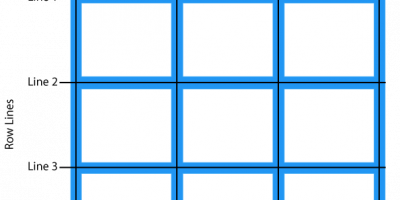Introduction:
CSS animations allow developers to animate the transition of HTML elements from one state to another smoothly. With CSS animations, you can create engaging, interactive web experiences without relying on JavaScript. In this article, we will explore the different properties used for CSS animations, how to create keyframe animations, and practical examples to demonstrate their power in web design.
1. Basic Concepts of CSS Animations
CSS animations work by defining the starting and ending states of an element, along with the intermediate steps (keyframes) in between. The animation can then control how the element moves, rotates, fades, or transforms.
CSS animations use two main properties:
@keyframes: Defines the intermediate steps or keyframes of the animation.animation: Shorthand for various animation-related properties, such as duration, timing, and the name of the keyframes.
Example: A Simple Fade-In Animation
@keyframes fadeIn {
from {
opacity: 0;
}
to {
opacity: 1;
}
}
.fade-in {
animation: fadeIn 2s ease-in;
}In this example:
@keyframes fadeIn: Defines the fade-in animation, starting withopacity: 0and ending withopacity: 1.animation: fadeIn 2s ease-in: Applies the fade-in animation to elements with thefade-inclass. The animation lasts for 2 seconds, and theease-intiming function makes the animation start slowly and speed up.
2. Animation Properties
Let’s explore the different CSS properties used to control animations.
animation-name: Specifies the name of the@keyframesthat defines the animation.animation-duration: Defines how long the animation takes to complete one cycle (e.g.,2sfor 2 seconds).animation-timing-function: Specifies how the animation progresses over time (e.g.,ease,linear,ease-in-out).animation-delay: Delays the start of the animation by a specified time (e.g.,1s).animation-iteration-count: Specifies how many times the animation should repeat (e.g.,infinite,1,3).animation-direction: Controls whether the animation should alternate directions (normal,reverse,alternate).animation-fill-mode: Defines how the element is styled before and after the animation (e.g.,forwards,backwards).
3. Creating Complex Animations with Keyframes
You can define more complex animations by using multiple keyframes. This allows you to control what happens at different points during the animation.
Example: A Bouncing Ball Animation
@keyframes bounce {
0% {
transform: translateY(0);
}
50% {
transform: translateY(-100px);
}
100% {
transform: translateY(0);
}
}
.bounce-ball {
width: 50px;
height: 50px;
background-color: red;
border-radius: 50%;
animation: bounce 1s ease infinite;
}In this example:
@keyframes bounce: Defines the animation where the ball moves up to -100px at 50% (halfway through the animation) and back to 0 at the end.animation: bounce 1s ease infinite: Applies the bouncing animation to the.bounce-ballelement, repeating infinitely.
This example creates a smooth bounce effect where a ball moves up and down continuously.
4. Staggering Animations with Delay
Sometimes, you want to animate multiple elements with a delay, creating a staggered effect.
Example: Staggering a Set of Boxes
@keyframes slideIn {
from {
transform: translateX(-100%);
}
to {
transform: translateX(0);
}
}
.box {
width: 50px;
height: 50px;
background-color: blue;
display: inline-block;
margin: 10px;
animation: slideIn 1s ease forwards;
}
.box:nth-child(1) {
animation-delay: 0s;
}
.box:nth-child(2) {
animation-delay: 0.2s;
}
.box:nth-child(3) {
animation-delay: 0.4s;
}In this example:
@keyframes slideIn: Defines an animation that slides the element from the left (translateX(-100%)) to its normal position.- Each box has a different
animation-delay, so they appear one after another in a staggered fashion.
The result is a set of boxes that slide into view one by one.
5. Using animation-fill-mode for Smooth Transitions
The animation-fill-mode property controls how the element’s style behaves before and after the animation. It can make an element retain the final state of the animation after it finishes.
Example: Keeping the Element in Its Final State
@keyframes grow {
from {
width: 50px;
}
to {
width: 200px;
}
}
.grow-box {
background-color: green;
height: 50px;
width: 50px;
animation: grow 3s forwards;
}In this example:
- The
grow-boxelement grows in width from 50px to 200px over 3 seconds. - The
animation-fill-mode: forwardsensures the box stays at 200px wide after the animation finishes, rather than reverting to 50px.
6. Combining Multiple Animations
You can apply multiple animations to a single element by separating the animation names with commas.
Example: Rotating and Fading an Element
@keyframes rotate {
from {
transform: rotate(0deg);
}
to {
transform: rotate(360deg);
}
}
@keyframes fadeOut {
from {
opacity: 1;
}
to {
opacity: 0;
}
}
.spin-fade {
width: 100px;
height: 100px;
background-color: purple;
animation: rotate 2s linear infinite, fadeOut 5s ease forwards;
}In this example:
- The element rotates infinitely using the
rotateanimation. - Simultaneously, it fades out over 5 seconds using the
fadeOutanimation.
By combining multiple animations, you can create more dynamic effects.
7. Hover and Focus Animations
CSS animations are often triggered by user interactions like hovering over or focusing on an element.
Example: Hover to Enlarge an Image
@keyframes enlarge {
from {
transform: scale(1);
}
to {
transform: scale(1.2);
}
}
.img-hover {
width: 200px;
height: 200px;
transition: transform 0.3s ease;
}
.img-hover:hover {
animation: enlarge 0.3s forwards;
}In this example:
- When the user hovers over the image, the
enlargeanimation is triggered, scaling the image to 1.2 times its original size. - This interaction creates a smooth zoom effect on hover.
8. Advanced Animation Techniques with Steps
The steps() timing function divides the animation into a specified number of discrete steps, which is useful for creating frame-by-frame animations like sprite animations.
Example: Sprite Animation Using steps()
@keyframes walk {
from {
background-position: 0;
}
to {
background-position: -600px;
}
}
.sprite {
width: 100px;
height: 100px;
background-image: url('sprite.png');
animation: walk 1s steps(6) infinite;
}In this example:
- The sprite image consists of 6 frames.
- The
steps(6)function ensures that the animation transitions between 6 distinct frames over 1 second, creating a walking effect.
9. Animating Text with CSS Animations
Text animations can add an engaging visual appeal to headings or important messages on a website.
Example: Typing Text Effect
@keyframes typing {
from {
width: 0;
}
to {
width: 100%;
}
}
.text-type {
overflow: hidden;
white-space: nowrap;
border-right: 3px solid black;
width: 0;
animation: typing 3s steps(30, end) forwards;
}In this example:
- The
text-typeelement simulates a typing effect by gradually increasing the element’s width. - The
steps(30, end)function ensures that the width is incremented in 30 equal steps, giving the appearance of text being typed.
Conclusion:
CSS animations are a powerful tool for creating interactive, visually engaging websites. With properties like @keyframes, animation-timing-function, and animation-delay, developers can create complex animations without relying on JavaScript. From simple transitions like fading and sliding to more advanced techniques like sprite animations




Leave a Reply